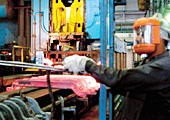 |
|
|
"Growth has been
coming from both the domestic markets and exports"
Baba Kalyani
Bharat Forge |
Late
September this year, auto parts giant Visteon, a former Ford Motor
subsidiary, opened a $10-million (Rs 46-crore) facility in Chennai.
Spread over 110,000 sq. ft, the Visteon Services and Technical
Centre will provide the parent company and its joint ventures
embedded software for everything from audio products to instrument
clusters to powertrain electronics to engine control modules.
Why open the centre in India and not the US? Two reasons: Engineering
design services are cheaper by about 70 per cent, and the skill
levels are high. "With the Indian automotive sector poised
for unprecedented growth, our Indian operations are a critical
asset in further developing Visteon's competitive edge,"
Visteon's Senior Vice President Bob Pallash said in a release.
Pallash isn't exaggerating. With some of
the biggest carmakers like Ford and General Motors bleeding, there's
unprecedented pressure on vendors such as Visteon to cut costs.
Manufacturing in India costs 30 to 40 per cent less than what
it does in the US. As a result, more and more of component manufacturing
and sourcing is moving to India. Back in 2001-02, auto part production
in the country was estimated at about $4 billion (Rs 19,200 crore
then). Last financial year, it was at $10 billion (Rs 45,000 crore
then). In that time, auto part exports have jumped from $578 million
(Rs 2,774.4 crore then) to $1.9 billion (Rs 8,550 crore), and
by 2015 a staggering $20-25 billion (Rs 92,000-1,15,000 crore)
worth of components is likely to be outsourced. Says Baba Kalyani,
Chairman of Pune-based Bharat Forge: "Growth has been coming
from both the domestic markets and exports. But if you don't put
your processes in place now, you will never be competitive."
| SECTORAL SNAPSHOT |
»
There are a little over 500 big component manufacturers,
of whom 472 have the ISO 9000 certification
» Exports
are worth $1.9 billion (Rs 8,740 crore), but by 2015 the figure
could touch $20 billion (Rs 96,000 crore)
» A third
of the component exports go to Europe, a quarter to the US,
and 16 per cent and 10 per cent, respectively, to Asia, and
Africa and Middle East
» Domestic
demand for auto parts is expected to touch $20 billion (Rs
92,000 crore) by 2015, putting the total industry size at
$40 billion (Rs 1,84,000 crore) |
Despite the boom, there are several challenges
that Indian suppliers need to overcome. One is that of capacity
itself. There are about 5,000 auto parts manufacturers in the
country, but only about 10 per cent of them are of any significant
size. Two, the industry so far has thrived on contract manufacturing.
That is, the vehicle manufacturer hands out specs and the vendor
merely makes them. So, original design and development skills
are severely limited. Three, quality is a major concern. Four,
most Indian vendors are either tier-two or tier-three suppliers,
with no direct access to the vehicle manufacturers.
But if a recent McKinsey & Co. survey
of Indian and Chinese suppliers is any indication, then Indian
vendors (like Chinese) are well on their way to addressing these
issues. The survey points to four key findings: Pre-conditions
for rapid growth have taken root. These are things like operational
skills, global customer access and factor cost advantages that
go beyond manufacturing. Two, vendors are moving from "module
assembly path (read: physical assembly of proximate parts) to
R&D/integration path, which involves designing sub-systems
that are integrated through technology". Three, "highly
successful suppliers are pursuing aggressive step-outs towards
exports and/or globalisation". Four, the top suppliers have
aspirations of becoming global tier-one suppliers and are leveraging
M&As overseas to "bridge the capability gaps in scale
and skill".
 |
| There are about 5,000 auto parts manufacturers
in India, but only about 10 per cent are of any significant
size |
Indeed. There has been a spate of overseas
acquisitions in the recent years. Kalyani's Bharat Forge, for
instance, has acquired six companies abroad in the last five years;
Sundram Fasteners, a TVS Group company based in Chennai, hasn't
just bought vendors abroad (most recently, a German automotive
fastener manufacturer Peiner Umformtechnik for m8.24 million),
but set up a facility in China; Sona Koyo, a Delhi-based manufacturer
of steering systems, acquired a 21 per cent stake in Fuji Autotech
two years ago; and Amtek Auto, another Delhi-based vendor, bought
a 70 per cent stake in Germany's Zelter (a manufacturer of turbocharger
housing) in July 2005 for about m20 million. Says Suresh Krishna,
Chairman and Managing Director of Sundram Fasteners: "We
have an edge in terms of blue- and white-collar labour. Skilled
work can be done here and at lower costs than developed countries."
Kiran Deshmukh, coo of Sona Koyo, says that his company plans
to increase exports from 15 per cent to 45 per cent of total production
by 2010.
The McKinsey report says that Chinese and
Indian suppliers "represent a strong disruptive force on
the global automotive stage". In the same breath, it adds
that the vendors will need to transform their business models
and build new capabilities. How? There are four things the suppliers
need to do, according to the report. Pick a segment and create
global scale in it; focus on operational excellence; move from
mere manufacture of components to design and development of component
systems by focussing on R&D; and continue to export and acquire
companies abroad to become more global.
As for global vendors like Visteon, they
will continue to move more of manufacturing and design work to
India. For some of them, low-cost countries like India may be
their only hope of survival.
|







